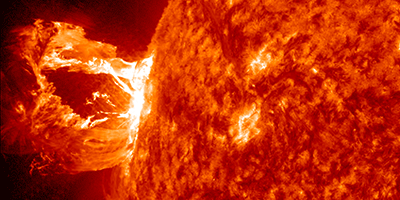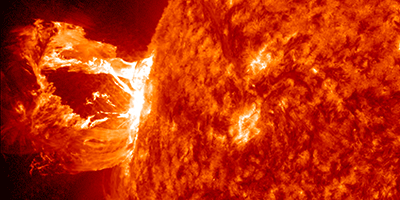Unexpected Impact from Medium-Sized Solar Flare
High-energy particles from the Sun can cause effects in the lower atmosphere, as recorded by a meteorological balloon flying over England during a moderate solar flare last year. Despite this being a rather weak event that was missed by other detectors, researchers observed increased ionization in the lower atmosphere, as well as changes in atmospheric electricity, causing them to argue in Physical Review Letters that the atmospheric impact from weak solar flares may be underestimated.
During a solar flare or related event, the Sun emits high-energy protons and other nuclei that together go by the name solar energetic particles (SEPs). Some of these SEPs can penetrate the Earth’s magnetic field and reach our atmosphere, where they cause ionization through collisions with air molecules. The flux of SEPs is determined by satellites, as well as by ground detectors that record particle showers produced by the highest energy SEPs.
The effect of SEPs in the lower atmosphere, between satellite orbits and ground detectors, has been studied infrequently. To access this region, Keri Nicoll and Giles Harrison of the University of Reading in the UK recently developed a balloon-borne experiment, a so-called Geigersonde, which records ionization up to altitudes of kilometers. When a medium-sized M-class solar flare triggered an SEP event on April , 2013, the researchers launched their balloon and recorded a increase in ionization at an altitude of kilometers. The lack of any coincident ground detection from surface instruments suggests that SEP-induced ionization in the lower atmosphere is not well detected by current observational techniques. During the SEP event, Nicoll and Harrison also recorded substantial fluctuations in atmospheric electrical properties associated with cloud behavior, suggesting that increased ionization during SEP events could affect weather phenomena. – Michael Schirber





